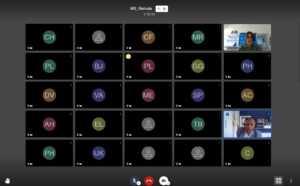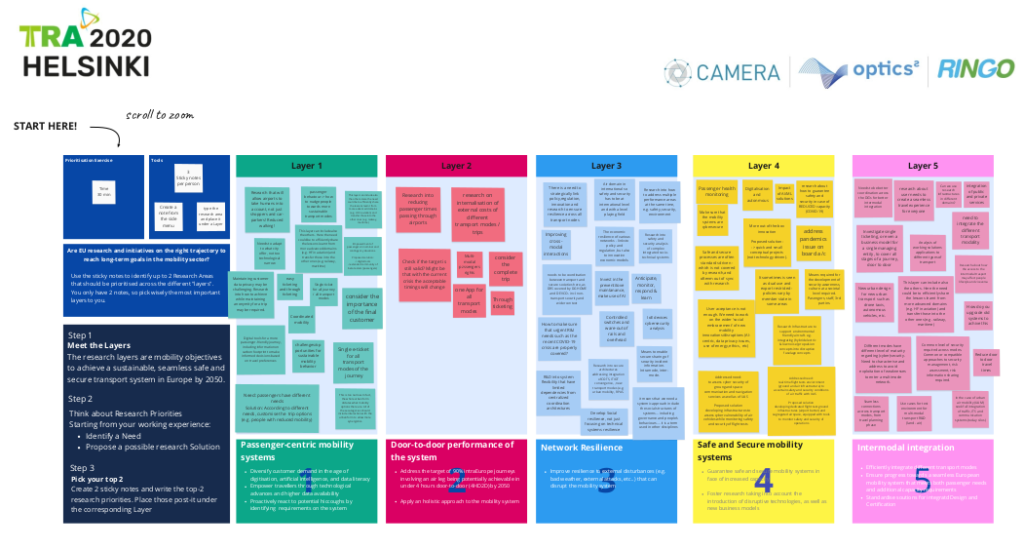![TRA2020_invited-session_B[24913] Welcome to the TRA2020 Invited Session on Mobility](http://www.optics-project.eu/wp-content/uploads/2020/05/TRA2020_invited-session_B24913.jpg)
“How far is Europe from the mobility goals envisioned for the future?”
This was the title of the TRA2020 invited session organised by three H2020 funded CSAs: CAMERA (Coordination and support Action for Mobility in Europe: Research and Assessment), OPTICS2 (Observation Platform for Technological and Institutional Consolidation of research in Safety and Security) and RINGO (Research Infrastructure. Needs. Gaps. Overlaps). Deep Blue, project coordinator of OPTICS2 and partner in CAMERA and RINGO, coordinated the event.
The session took place virtually on Monday, 22nd of June. It aimed at understanding whether EU research and initiatives are on the right trajectory to reach long-term goals in the mobility sector, and how to foster synergies between aviation and other transport domains.
The CAMERA and OPTICS2 websites streamed it simultaneously; their joint effort resulted in a seamless, entertaining and successful workshop. The event was highly and proactively participated. Most of the 60 participants, as well as the panelists, remained more than an hour after the end of the session to continue discussing the results of the interactive session and of the three projects.
FULL PRESENTATIONS
THE INVOLVED PROJECTS: CAMERA, OPTICS2, RINGO
The invited session focused in particular on the CAMERA, OPTICS2, and RINGO projects, which share similar overall objectives despite covering different thematic areas.
- CAMERA has the main goal to give a picture of the mobility research ecosystem in Europe. Therefore, it is the most cross-modal project since it takes into account research projects, not only in the aviation domain.
- Instead OPTICS2, which is the follow-up of the OPTICS project, has the aim to review the state-of-the-art of safety and security research, assessing current progress against the goals set out by Flightpath 2050 and ACARE Strategic Research Agenda.
- Finally, RINGO had the objective to take a picture of needs, gaps and overlaps of research infrastructures in the aviation field and develop operational and business models for a suitable and sustainable management of research infrastructures.
Overall, the three projects share a common methodological approach. They complement bottom-up desk studies of past and ongoing research with top-down input collected from domain experts through interviews, workshops, and surveys.
CAMERA automatically analyses FP7 and H2020 projects. OPTICS2 identifies the relevant research projects among those funded by FP7 and H2020, and also other national, international, and EU-funded programmes. Then, the consortium members analyse them, following a methodology developed during the OPTICS project. Finally, RINGO collects bottom-up input from existing infrastructure catalogues.
DESCRIPTION OF THE SESSION AND MAIN STATEMENTS:
The session started with introductory sections presenting the three CSAs to the audience. Then, an interactive section followed, to collect participants’ feedback on EU research on mobility. A panel discussion closed the day.
Setting the scene
A few icebreaking questions allowed us to get to know the audience expertise and transport domain. Then, Andrea Gentili from the European Commission (DG-RTD) gave a presentation on how the EC plans to address research bottlenecks in the field of transport (click to download the full presentation). Subsequently, Micol Biscotto of Deep Blue gave an overview of the three projects, highlighting synergies and describing the main results so far.
The CAMERA project
CAMERA automatically analysed the abstracts of more than 40.000 projects on the CORDIS database. Of these, 926 were identified to be contributing to achieve mobility goals in different sectors. Powered by a set of algorithms of natural-language processing, the CAMERA methodology classified the projects in nine broad topics related to mobility. The two topics which received the overall greatest financial contribution are “Security systems in transport and mobility” and “Novel concepts in mobility”. By contrast, the topic “Intelligent machines and automation in transport” is still rather a niche area of research, though it has seen a great acceleration in recent years.
The OPTICS2 project

OPTICS2 State-of-the-Art of Safety and Security Research is organised according to the ten Action Areas defined in the ACARE Strategic Research Agenda (SRIA2 ,revised in 2017 by ACARE). OPTICS2 selects the projects and maps them onto the action areas, action lines and action elements. Afterwards, it assesses them against a number of criteria, e.g. Coverage, Maturity, Ease of adoption, etc. The results of the assessment are internally moderated and subsequently sent to the project coordinator for a final feedback. Then, the summary of the results feeds the yearly State-of-the-art Report. Regarding safety, the most covered action areas are 5 (Safe design, manufacturing and certification), 4 (Safe operations) and 2 (Human and organizational factors). As for security, the projects assessed are more or less evenly distributed among all the action areas.
The RINGO project
RINGO published its final report in May 2020. RINGO studied the existing research infrastructures in the aviation field and highlighted needs and problems to address. The main findings were that 37% of the needs could be already covered by existing infrastructure. This points to the necessity of a greater commitment to coordination and matching between demand and offer across Europe.
Interactive section
During this session, the participants split into five breakout rooms. We asked them to identify up to 3 research priorities that, in their opinion, would need further investment in the future. This was done by placing virtual post-its on an interactive MIRO board.
We had previously organised the research priorities in 5 macro areas, or ‘layers’ in the jargon of CAMERA. These correspond to mobility objectives for a seamless, safe and secure transport system in Europe by 2050:
- ‘Passenger-centred mobility system’
- ‘Door-to-door performance of the system’
- ‘Network resilience’
- ‘Safe and Secure mobility systems’
- ‘Intermodal integration’
The main results of the breakout rooms were:
- The majority of the research priorities identified are under layer 5 (Intermodal integration).
- Layer 2 (door-to-door performance) was the research area with the smallest number of priorities.
- The most frequent keywords identified by the participants were single-ticketing, integration of services, empowering passengers, user-needs, cybersecurity, Covid-19.
Panel discussion

Peter Hullah of EUROCONTROL moderated the panel discussion that closed the invited session. The discussion involved representatives from the three projects and the EC: Mariken Everdij for OPTICS2, Christophe Hermans for RINGO, Paula Lopez Catala for CAMERA, and Andrea Gentili for the EC- DG RTD.
The panelists answered the questions coming from the audience, and discussed the results of the breakout rooms.
CONCLUSIONS
We started the session with the question: “How far is Europe from the mobility goals envisioned for the future?”. It was a provocative question that couldn’t have been addressed by just one (remote) session. However, the discussion that emerged from the different interactive sessions, showed that there is a potential gap, between the perception of the sectors in which there is most EC funded research and the actual results of the different projects carried out in the recent years.
A lot of quality research is carried out in Europe and the result of the three H2020 CSA show that the ACARE Strategic Research Agenda is covered in many aspects that enable an intermodal, safe and secure integration of the mobility systems. Advanced solutions to improve the quality and the performance of the mobility system are already available. Still the complex nature of the integration of the mobility goals for the future, the technological progress (e.g. new disruptive concepts or business models) or the always-changing nature of unexpected events (e.g. global pandemic crisis) can constantly challenge the achievement of those goals. Pushing researchers, legislators and industries to keep improving toward a more integrated, user-centric and resilient mobility system.
powered by Deep Blue

